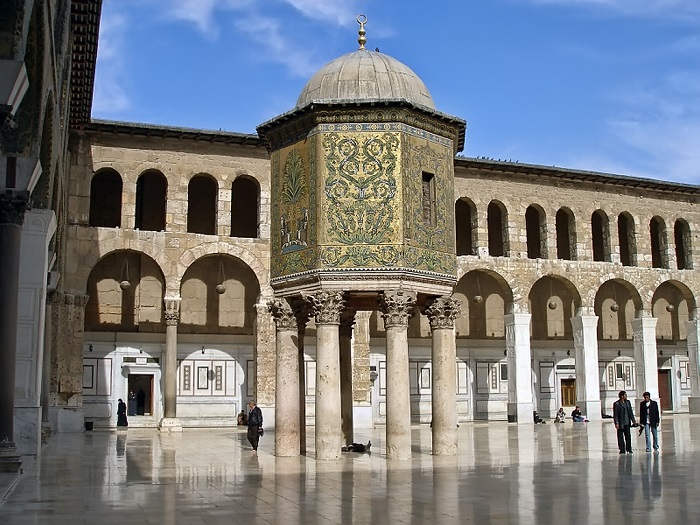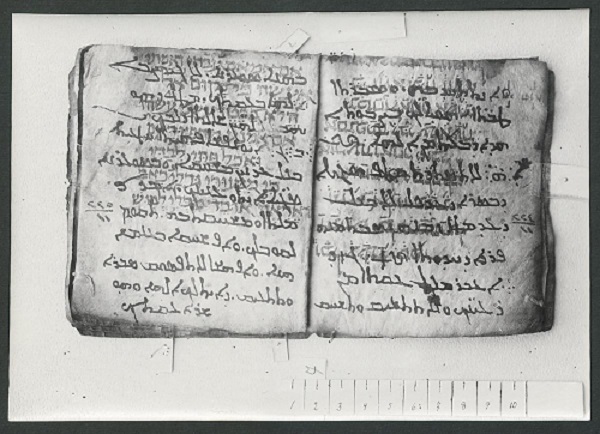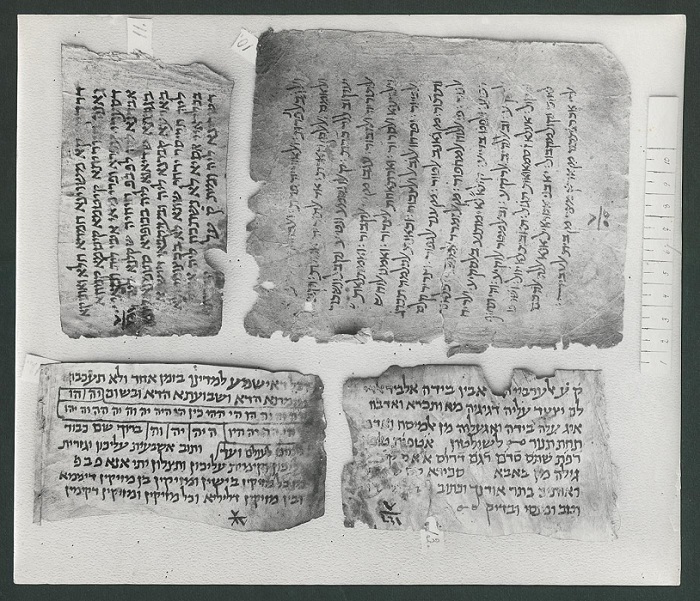A Muslim Genizah in Damascus
During his consular service, Edward Thomas Rogers (1831–84) became a spirited traveller, diplomat and collector. In Syria he caused a scandal when he opened the Qubbat al-Khazna at the ancient Umayyad Mosque in Damascus and came into possession of some precious ancient manuscripts that had been consigned there. The most sensational among these was a fragment of the Greek New Testament. The incident followed hot on the heels of Tischendorf’s discovery of Codex Sinaiticus in 1844, and came to the attention of European manuscript hunters, including ultimately the German Professor Hermann von Soden (1852–1914). Von Soden had been working on a new edition of the Greek New Testament in Berlin and, endowed by a patron with the right means, he set out to gather new sources for textual criticism. In feverish excitement, von Soden imagined discoveries in the Qubba that could rival all others. As Schechter would unearth the great riches of the Cairo Genizah some years afterwards, scholars later deemed it appropriate to use the term “genizah” for the newly discovered Damascus hoard.

Qubbat al-Khazna, by Roberta F. [CC BY-SA 3.0 (https://creativecommons.org/licenses/by-sa/3.0)], from Wikimedia Commons
The Qubbat al-Khazna—the “Treasury Dome”— is located in the courtyard of the Umayyad Mosque. It still stands there today, on eight Roman columns, an octagonal structure decorated with mosaics. There, in a chamber with a diameter of approximately six and a half metres, protected from harm by a heavily locked iron door, and only reachable with the help of a ladder, a pile of manuscripts—as high as one man standing upright—had found its final rest. The chamber mostly held old Qurans and literary manuscripts, but there were also Hajj certificates and documents pertaining to everyday life, such as marriage and divorce contracts, and various other kinds of deeds. The fragments had originally been placed there, together with other “worn-out” manuscripts, following the usual practice of storing away sacred books and important documents that were too fragile to remain in circulation or which had fallen out of use. They were not intended for subsequent retrieval or to form an archive, but the practice was rather a ritualized burial resulting from an esteem for, or a fear of desecration of, the written word. Muslims, Jews, and Christians shared this practice.
On von Soden’s initiative, the German emperor and Prussian king Wilhelm II urged the Sublime Porte by diplomatic means to allow a scholar to go through the material and study it thoroughly. Wilhelm II had only just returned from an historic visit to the Holy Land, where he and his consort, Augusta Victoria, were shown the Umayyad Mosque and the Qubba. This visit had strengthened the alliance between Prussia and the Ottoman Empire. Permission for a further study of the contents of the qubba was granted by the Sultan Abdul Hamid II in the form of an irāda. The irāda also instructed Wali Nazim Pasha, governor of Damascus, to carry out and oversee the opening of the Qubba. Funding for the expedition was secured, and a young German scholar, Bruno Violet, was chosen to undertake it. He arrived in Damascus on May 30 1900 and commenced his task.
Simple rules were set down by the mosque’s authorities: the Prussian gentleman could consult all fragments except those of Muslim provenance. He recounts that Muslim fragments—mostly Quranic fragments, Hajj certificates and legal documents—were immediately taken away from him and stored in sacks. The remaining, non-Muslim, fragments were cleaned, pressed, and conserved by the modest means available to Violet. Some of them he also photographed.[1] After about a year, his work approached completion; it had increasingly caused suspicion and dismay among locals. Hastily, he photographed a selection of fragments before he departed for Berlin on July 2 1901.
Another irāda of Abdul Hamid II gave permission for the collection to be sent to Berlin on loan. Before the fragments were dispatched, however, the whole batch was inventoried and photographed by the Ottoman authorities. The number of fragments at this time was given as 1558. The collection arrived in Berlin on June 17, 1902, and was deposited at the Royal Museums; in 1904, it was moved to the State Library. It consisted mainly of Jewish, Christian, and Samaritan texts, in a variety of scripts and languages: Greek, Hebrew, Samaritan, Latin, Coptic, Syriac, Christian Palestinian Aramaic, and even Armenian. Among the fragments, many were palimpsests or had been re-used as the bindings of books. Unexpectedly after six years, in December 1908, the Ottomans demanded the return of the fragments. A prioritized list of 54 fragments, prepared by von Soden, and an almost complete Syriac codex was all that could be photographed before the collection was sent back in its entirety.[2] The Ottomans confirmed that the collection reached Istanbul; however, its current whereabouts remain a matter of conjecture since then.
Violet’s collection consists of a small though significant fraction of the Damascus Genizah. The larger part, which amounted to perhaps 99.5% of the Qubba’s contents, was transferred to Istanbul. The majority of the fragments were housed eventually at the Türk ve İslam Eserleri Müzesi, the Turkish and Islamic Arts Museum, where the collection was called şâm evrakları “Damascus papers”. An inventory made in 1955 numbers 13,882 items, with a total of 211,603 pieces.
The surviving photographs contain Jewish fragments. Among these are a ketubba, a Judaeo-Arabic glossary of the Mishna and a commentary on Leviticus. A number of folios contain the Hebrew Bible, Job 31, with full Tiberian vocalization and accents, overwritten with an unidentified Syriac text.
Photographs of selected fragments from the Umayyad Mosque in Damascus in different languages, 1908. Staatsbibliothek zu Berlin, Mss. simulata orientalia 6 (CC-BY-NC 3.0)
Seven intact folios of a Babylonian Jewish Aramaic booklet on magic have been published by Gideon Bohak and Matthew Morgenstern.
Photographs of selected fragments from the Umayyad Mosque in Damascus in different languages, 1908. Staatsbibliothek zu Berlin, Mss. simulata orientalia 6 (CC-BY-NC 3.0)
Manuscript Cultures in Medieval Syria: Towards a history of the Qubbat al-khazna depository in Damascus
Together with Prof. Dr. Arianna D’Ottone Rambach (Sapienza - Università di Roma) and Prof. Dr. Konrad Hirschler (FU), the present author will convene a conference on the Qubbat al-khazna of the Umayyad Mosque in Damascus, which stands as one of the most significant, albeit little known and poorly researched, manuscript repositories in the Middle East.
For further details on the program, see http://www.geschkult.fu-berlin.de/e/islamwiss/Termine/Program-and-time-s...
References:
Bandt, Cordula, and Arndt Rattmann. “Die Damaskusreise Bruno Violets 1900/1901 zur Forschung der Qubbet el-Chazne.” Codices Manuscripti 76/77 (2011): 1–20.
Bohak, Gideon and Matthew Morgenstern. “A Babylonian Jewish Aramaic Magical Booklet from the Damascus Genizah.” Genzei Qedem 10 (2014), 9–44.
D’Ottone, Arianna, and Paolo Radiciotti. “I frammenti della Qubbat al-Khazna di Damasco. A proposito di una scoperta sottovalutata.” Nea Rhōmē 5 (2008), 45–74.
D’Ottone, Arianna. “Manuscripts as Mirrors of a Multilingual and Multicultural Society: The Case of the Damascus Find.” In Negotiating Co-existence: Communities, Cultures and Convivencia in Byzantine Society, edited by Barbara Crostini and Sergio La Porta, 63–88. Trier: Wissenschaftlicher Verlag Trier, 2013.
Footnotes
[1] Violet’s photographs are found today in the Berlin-Brandenburg Academy of Science, with the shelf-mark BBAW/GCS, Akz.-Nr. 481.
[2] These photographs are kept today in two folders in the Staatsbibliothek in Berlin, Or. Sim. 5 and Or. Sim. 6. The former contains a Syriac translation of Theodore of Mopsuestia’s commentary on Qoheleth, which has been published by Werner Strothmann, Das syrische Fragment des Ecclesiastes-Kommentars von Theodor von Mopsuestia: Syrischer Text mit vollständigem Wörterverzeichnis (Wiesbaden: Harrassowitz, 1988). Von Soden’s selection, reflecting his interest in research, mostly encompasses biblical texts. The second folder of photographs was thought to have been lost in the turmoil of the Second World War, but resurfaced at the Staatsbibliothek in Berlin in 1999, and the photographs are at http://digital.staatsbibliothek-berlin.de/werkansicht?PPN=PPN685013049&P...
Cite this article
(2018). A Muslim Genizah in Damascus. [Genizah Research Unit, Fragment of the Month, June 2018]. https://doi.org/10.17863/CAM.34051
If you enjoyed this Fragment of the Month, you can find others here.
Contact us: genizah@lib.cam.ac.uk
The zoomable images are produced using Cloud Zoom, a jQueryimage zoom plugin:
Cloud Zoom, Copyright (c) 2010, R Cecco, www.professorcloud.com
Licensed under the MIT License


